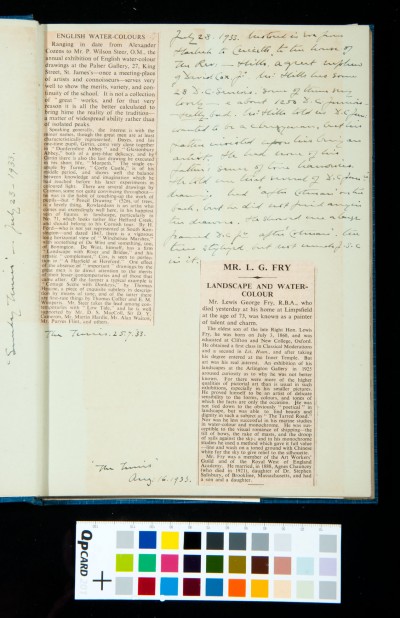Cotmania. Vol. IX. 1933-4
Archive: SDK Sydney Decimus Kitson Archive
Reference Number: SDK/1/2/1/9
Page: p.2 recto
-
Description
Clipping no. 1/journal entry/clipping no.2
Clipping from The Times reviewing the annual English water-colour exhibition at Palser Gallery including some works attributed to Cotman; journal entry detailing trip to see works by D. Cox Sr. and Jr.- some works of the latter supposedly in the style of Cotman; clipping from The Times on Water-colour artist L.G. Fry.
Date: 23/07/1933—16/08/1933
-
Transcription
{clipping no. 1}
The Times 25/07/1933
English Water-colours
Ranging in date from Alexander cozens to Mr. P. Wilson Steer, O. M., the annual exhibition of English water-colour drawings at the Palser Gallery, 27, King Street, St. James's—once a meeting-place of artists and connoisseurs—serves very well to show the merits, variety, and continuity of the school. It is not a collection of "great" works, and for that very reason it is all the better calculated to bring hime(sic) the reality of the tradition—a matter of widespread ability rather than of isolated peaks.
Speaking generally, the interest is with the minor names, though the great men are at least characteristically represented. Days and his one-time pupil, Girtin, come very close together in "Dunfermline abbey" and "Glastonbury Abbey", both of a grey-blue delicacy, and by Girtin there is also the last drawing he executed in his short life, "Morpeth." The single example by Turner, "Corfe Castle," is of his middle period, and shows well the balance between knowledge and imagination which he had reached before his later experiments in coloured light. There are several drawings by Cotman, some not quite convincing throughout—he was in the habit of touching-up the work of pupils—but "Pencil Drawing" (52B), of trees, is a lovely thing. Rowlandson is an aritst who comes out exceedingly well here, in his happiest vein of figures in landscape, particularly in No. 71, which looks rather like Helford Creek, and should belong to his Cornish tour. By H. Ford—who is not yet represented at South Kensington—and dates 1847 there is a vigorous long horisontal view of "Winchelsea Marshes," with something of De Wint and something, too, of Bonington. De Wint himself, has a firm "Landscape with River and Bridge," and his artistic "complement," Cox, is seen to perfection in " A Hayfield at Hereford." One effect of the absence of "important" drawings by the great men is to direct attention to the merits of their lesser contemporaries and of those that came after. Of the former a typical example is "Cottage scene with Donkeys," by Thomas Hearne, a piece of exquisite subtlety in description by means of tone, and of the latter there are first-rate things by Thomas Collier and E. M. Wimperis. Mr. D.S. MacColl, Sir D. Y. Cameron, Mr Martin Hardie, Mr. Alan Walton, Mr. Purves Flint, and others.{journal entry}
28/07/1933
[Husband] to [Eva] James [illegible 1 word] to [Cuccitti] to the house of the Rev: — Hills, a great nephew of David Cox Jr. [Mr] Hills has some 28 D. C. Seniors some of them very lovely— & about 1250 D. C. Juniors— really bad. Mr Hills told us that D. C. Junior: wanted to be a clergyman, but his father insisted on his becoming an artist. He has some of his father’s sense of the harmonics. He told me that several of D. C Juniors had ‘after Cotman’ on the back, but he did not find any in the [illegible 1 word]. He showed me a large framed D. C. Jr after ‘Cotman’. [illegible 1 word] thus styled but not enough J.S.C in it.
{clipping no. 2}
‘The Times’ 16/08/1933
Mr. L. G. Fry
Landscape and Watercolour
Mr Lewis George Fry, R.B.A., who died yesterday at his home at Limpsfield as the age of 73, was known as a painter of talent and charm.
The Eldest son of the late Right Hon. Lewis Fry, he was born on July 3, 1860, and was educated at Clifton and New College, Oxford. He obtained a first class in Classical Moderations and a second in Lit. Hum., and after taking his degree entered at the Inner Temple. But art was his real interest. An exhibition of his landscapes at Arlington Gallery in 1925 aroused curiosity as to why he was not better known. For there were more of the higher qualities of a pictorial art than is usual in such exhibitions, especially in his smaller pictures. He proved himself to be an artist of delicate sensibility to the forms, colours and tones of which the facts are only the occasion. He was not tied down to the obviously “poetical” in the landscape, but was able to find beauty and dignity in such subjects as “The Tarred Road.” Nor was he less successful in his marine studies in water-colour and monochrome. He was susceptible to the visual romance of shipping—the tilt of the bows, the rake of masts, and the drop of sails against the sky; and in his monochrome studies he used a method which gave it full value— line and wash on a toned ground with Chinese white for the sky to give relief to the silhouette.
Mr. Fry was a member of the Royal west of England Academy. He married in 1888, Agnes Chauncey (who died in 1921), daughter of Dr. Stephen Salisbury, of Brookline, Massachusetts, and had a son and a daughter.
